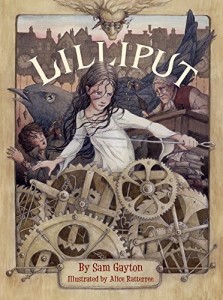A title that immediately drew me in at BEA last month was Sam Gayton’s forthcoming August US release of Lilliput featuring illustrations by Alice Ratterree from Peachtree Publishers . I’m happy to have it as my first Subcultured #Goodbooks feature; a new column where we showcase and discuss upcoming books, comics and graphic novels for all ages. It’s also one of my picks on our Staff Summer Reading list!
Lilliput, as the name suggests, features the iconic Lilliput from Jonathan Swift’s 1726 satire Travels into Several Remote Nations of the World. In Four Parts. By Lemuel Gulliver, First a Surgeon, and then a Captain of Several Ships, or better known as the much, much shorter Gulliver’s Travels.
The plot is initially rather simple; Gulliver himself has returned to Lilliput. His goal? To collect a Lilliputian and take them back to London to prove that all the stories of his travels are true. His captive? Young Lily, a small Lilliputian only a few moons old. In Gayton’s world (and perhaps this applied to the original) Lilliputians lives are much shorter than ours, measured by the moon. Each day young Lily is held captive she grows older and older. After Gulliver sails back and takes her to his rented room above clock-maker’s shop , where he keeps Lily captive in a bird-cage while he finishes his (now famous) manuscript. Lily, proactive, headstrong and growing older and older by the day, plots to get back to Lilliput before everything she knew there is gone and the beginning of the book follows her various plans for escape. It’s not until a message she sends out on a mouse’s tail is found by the clock-maker’s “apprentice” a young boy named Finn does the story blossom and the true villain, the stinky clockmaker Mr. Plinker, is revealed.
Sam Gayton writes a wonderful story here, entrenched in the “shadows, mice, thimbles, feathers and candles” realm of children’s literature, often taking a turn for the dark. Here people are nasty and cruel, like the true villain of the book, Mr. Plinker. Mr. Plinker keeps young Finn as his apprentice and a literal watch-bound slave with a dangerous automaton strapped to his arm that squeezes him if he wastes time. Brought together by their plights, Lily and Finn find a deep connection and work together to escape both their captors.
Gayton’s prose is refreshing for the genre; dipping into very poetic and surprisingly mature metaphors and images, particularly relating to the almost fairy-like (but not quite) Lilliputians. Their tears for instance, are described as mists that hang about their heads and they have a vaguely magical way of learning information and reading minds when they look into people’s eyes. This inane “maybe” magic that Lily displays places Liliputians a bit more mystical category than your average Borrower, but not as overdone as a “garden variety” fairy. The effect is very memorable.
Amidst the whimsy there are indeed stark and scary moments that can prove to be quite jarring as we follow Lily and Finn’s struggles, from grizzly displays of Lilliputian bones to Lily being dropped into a dirty flea ridden sock and being bitten all over to her having to remove the cinching torture device from upon Finn’s wrist. These rather bloody and scary images require a discerning reader and places the book between both children’s and middle grade fiction. The end in particular takes a rather grizzly (if not not slightly overblown) turn.
The book is not 100% historically accurate either, feeling more like a Dickens novel at times than an early 18th century romp, and indeed has a certain “clockpunk” (pre Victorian era application of steampunk style sci-fi with an emphasis on clockwork automata) feel due to Mr. Plinker’s cruel automatons. This is emphasized by Alice Ratterree‘s delicate clockpunkish artwork and cover which feature the clock gears of the various clocks and devices Lily encounters.
However there is a touch of realism to the 18th century London too as seen in a Spanish hot chocolate house and shopkeeper who proves invaluable to Lily and Finn, and emphasis on the city being filthy. There is also topical commentary on orphanages and child slavery and servitude, etc. While the book does take some sinister and nasty Gothic turns which leaves the tone somewhat beguiling (especially the end which hurts the book), the book is ultimately still rather enjoyable and about kindness, and that’s a message and trait we should always encourage to have more than a thimble’s worth of. Overall Liliput is highly recommended for kids and tweens getting into meatier novels and can handle some scary (and surprisingly bloody) content. A by no means tiny first #goodbook.
Got any #goodbooks we should know about? Tweet your #goodbooks to us on our twitter; @sub-cultured or at my twitter, @maxlikescomics!
Max Eber
Staff Writer
max@sub-cultured.com













